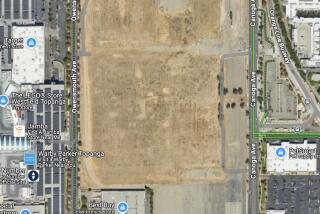Pier Scrapped : Port Finds Park Site Polluted
Water, fish and sediment in the San Diego Bay at the foot of Crosby Street are so toxic and polluted that the San Diego Unified Port District has scrapped its plans to build a fishing pier on the site as part of a neighborhood park.
The site of the proposed 3.2-acre park, long a source of controversy between the Barrio Logan community and the Port District, is sandwiched between industries along the bayfront. Straddling the proposed pier are businesses that store and dispense marine fuel, repair ships and store cargo in dock terminals.
Also nearby is the Chollas Creek outfall, which one environmental consultant to the Port District called a “notorious source of contamination” because it carries sewage spills into the bay.
Six Fish Analyzed
According to a study performed by Westec Services Inc., a chemical analysis of six fish caught off Crosby Street showed that one of the fish contained mercury at a level higher than what is considered acceptable under Federal Drug Administration standards.
Five of the six fish caught also showed levels of arsenic higher than acceptable standards established by the Food and Agricultural Organization of the United Nations, said the study, which was dated April 1.
“It is our opinion that fish caught at the Crosby Street project area could be contaminated and the Crosby Street site is not presently a desirable location for a fishing pier,” the study concluded. No numerical values for the toxic substances were included in the written summary of the study.
Water, Sediment Tainted
A second study showed that the water and sediment of the bay were contaminated as well.
Underwater soil samples taken Jan. 22 indicated “significantly elevated levels of the persistent and bioaccumulative toxic metals zinc, copper, lead, chromium and mercury,” according to a study by Woodward-Clyde Consultants.
That study, also dated April 1, revealed that mercury in the soil was found to be 1.6 parts per million, more than six times the 0.25 ppm threshold considered troublesome under guidelines established by the state Regional Water Quality Control Board. Previous samplings for other, non-industrial areas of the bay showed mercury to be 0.38 ppm, the report said.
Health Danger Cited
Lead was also found at more than five times the acceptable concentration--273 ppm versus the 56 ppm guideline. Chromium was at 37.4 ppm, higher than the water board’s guideline of 20 ppm. Non-industrial areas of the bay showed levels of lead and chromium at 15.5 ppm and 54 ppm, respectively.
The Woodward-Clyde study also showed that concentrations of pyrene and arochlor 1254, a PCB, are three times the acceptable levels, while two of nine water samples taken by the firm showed counts for coliform bacteria--an indicator of sewage--at levels that exceeded state standards for human body contact.
“The findings of this study indicate that sediment and water quality in the area are not currently compatible with the use of this location for sport fishing, in view of public health concerns,” the report concluded.
Blamed on Industries
Gary Clossin, the Woodward-Clyde project engineer who worked on the study, said the toxics result from the industries near the proposed park.
“We attribute it to the general industrialized area that this proposed site is located in, along with the shipyards,” he said.
Faced with those findings, port commissioners on Tuesday voted to scrap their plans for a fishing pier and have decided to opt instead for an octagonal viewing pier, said Dan Wilkens, the Port District’s director of community and government affairs.
That change, however, does not upset the Barrio Logan community, which has fought for years to have the district build a park at the foot of Crosby Street, said Ronald Trujillo, a member of the Chicano Park Steering Committee. The citizens group advises the district on plans for the park.
No Disappointment
“No, it’s not a big disappointment,” Trujillo said. “We’re glad that we’re getting the park.
“We’d like to be able to fish there, but when they were talking about the toxins in the soil, the Chicano Park Steering Committee and the residents of the area (said) the last thing we want to do is build a park where it is not safe,” said Trujillo.
Discovery of toxic fish, water and soil at the Crosby Street site comes as the Port District is pushing ahead with conceptual design of the park.
Other amenities to be included on the site are soccer and baseball fields, picnic tables, barbecue pits, sandboxes, a raised stage, a concessions stand, a boardwalk and public restrooms, said Wilkens.
The park is actually carved out of a 5.4-acre site, and the Port District agreed in December to end years of political bickering over the land by converting 3.2 acres of it to a neighborhood park. The California Coastal Commission approved the plan in February, 1987.
The remaining 2.2 acres will be used for light industry, said Wilkens.
More to Read
Sign up for Essential California
The most important California stories and recommendations in your inbox every morning.
You may occasionally receive promotional content from the Los Angeles Times.










